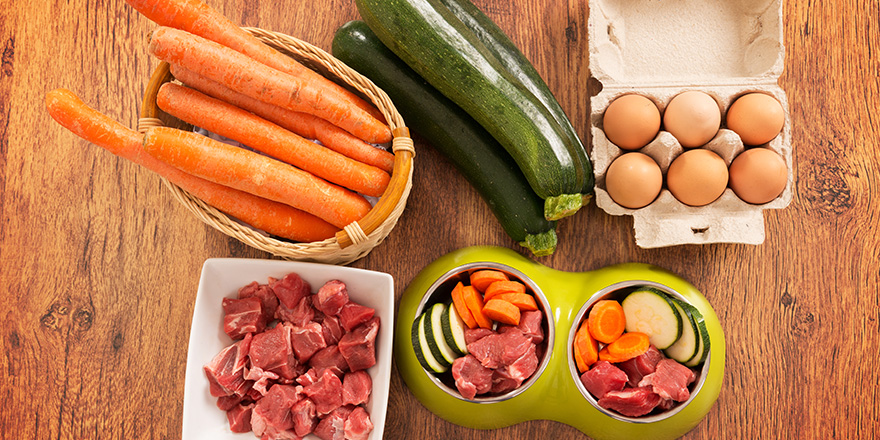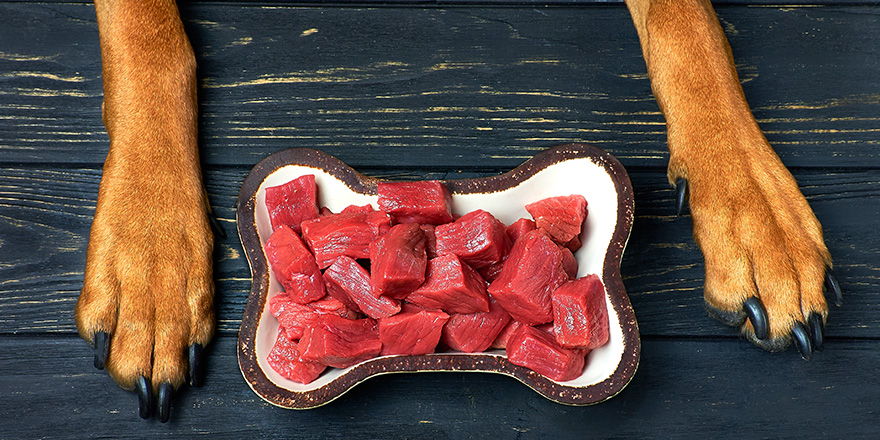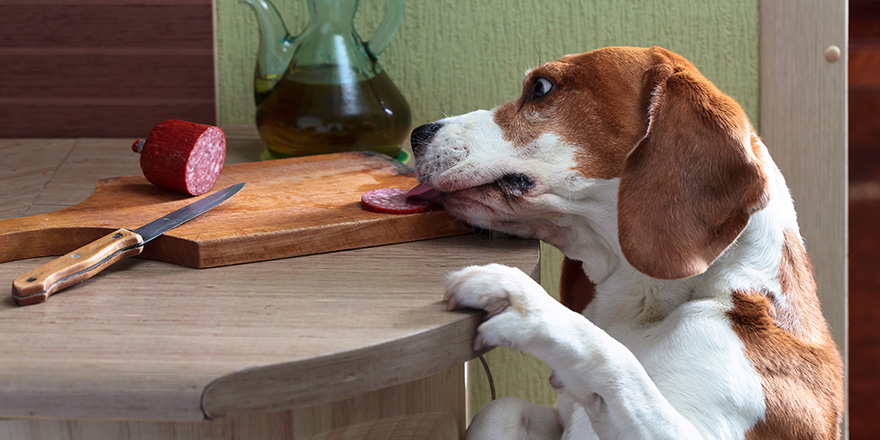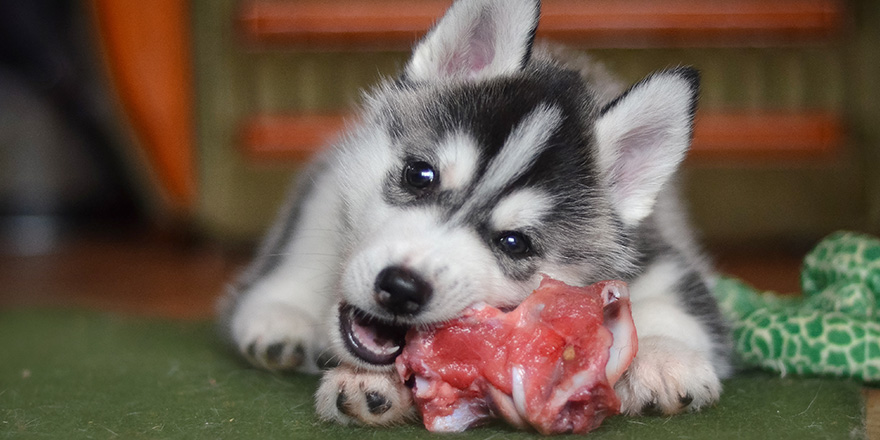While your pupper may love to devour that meaty treat or go wild over a piece of chicken, the modern canine is not actually a true carnivore. Even their wild ancestors, the wolf, would boost their nutritional intake with plant and animal protein sources. This means that contrary to common perceptions, dogs are more like omnivores.
But what does this mean, and are grains and vegetables beneficial for your pooch?
We explore all the issues around the question – are dogs carnivores or omnivores? – and give you all you need to know to provide your pet with a balanced diet to help them thrive.
Are Dogs Carnivores or Omnivores?

There are three categories of diet for animals: carnivore, omnivore, and herbivore. And when it comes to canines, one category – the herbivore – can immediately be ruled out.
To be a herbivore, an animal will only eat plant material, and its physiology and anatomy will be adapted to eat and digest such a diet. Examples of herbivores include cows, rabbits, and horses.
By nature, domesticated dogs are not natural herbivores as they have evolved from meat-eating hunters. But that doesn’t necessarily mean they should exclusively eat a meat-only diet.
However, this is where a debate in the scientific and veterinary world has continued for many years, with discussions on whether domestic dogs are pure carnivores or omnivores by nature.
The crux of the matter is how well a canine can digest plant-based food as, unlike a cat which requires meat to survive, today’s domesticated dogs can also thrive on a diet that combines animal protein and plant-based ingredients.
But a dog’s digestive system doesn’t process plant materials as efficiently as meat, meaning that while they can be classified as an omnivore, a dog’s diet naturally leans towards the carnivore end of the spectrum!
Omnivore and Carnivore – The Difference Between the Two

Before we start exploring in more depth the ideal diet you should aim to feed your dog, we look at what omnivore and carnivore really mean and the key differences between the two.
Carnivore
Carnivore is Latin for ‘eating or feeding on flesh’ and relates to an animal that almost exclusively lives on a meat-based diet. True or obligate carnivore species include wolves, big wild cats (and domesticated cats), hyenas, and polar bears. And, as hunting animals, carnivores require energy and a protein-rich diet to support their highly active lifestyle.
One of the main differences between pure carnivores and omnivores is their teeth, which have evolved to match the diet they eat. Carnivores have sharp teeth to tear and shred raw meat and have a simple but effective up-and-down chewing action.
Carnivore doesn’t need to chew their food very much – just enough to send it down the esophagus – and they have a simpler digestive system than an omnivore and herbivore. This is because it is easier to extract nutrients from protein than plant matter, so carnivores have a shorter digestive tract. They also have a specialized enzyme in their stomach that is specifically for digesting meat.
Omnivore
The word ‘omnivore’ derives from Latin, and in a simple translation, means “eats everything”. This means omnivores not only eat meat and animal-based proteins but fruits, vegetables, and grains as part of their everyday diet. Humans are prime examples of an omnivore.
The omnivore has a different jaw shape and chewing action to the carnivore to ensure they can chew and digest a wider range of food types. Unlike the carnivore, which has jaws that only move up and down to tear apart meat, true omnivores have both an up and down and sideways jaw movement for a more versatile chewing style.
The omnivore’s teeth are also adapted to their meat and a plant-based diet, with flat molars to support chewing plant material. However, omnivores can also have fang-like canine teeth, especially in a species such as the domesticated dog, which has evolved from a carnivore and still has a meat-rich diet.
The Modern Dog’s Digestive System

Considering the differences between carnivores and omnivores, we can now start to understand how the modern canine has changed from the wild wolf to the domestic pet we know and love today through dog evolution. And this can also help us to answer the question – are dogs obligate carnivores?
And at the heart of this answer is the development of the modern dog’s digestive system, which underpins the canine’s transition from hunting carnivore to meat and plant-eating pet.
How a modern dog eats and extracts all the essential energy and nutrients from its dog food is the result of how it has adjusted to more of an omnivore diet. This includes:
An Evolved Intestine
Intestinal length is the quickest way to identify an omnivore from a physiological perspective. As plants are more complex to digest than animal protein, an omnivore requires a longer digestive tract to give their system more time to do its job. This means a carnivore will have a shorter small intestine than an omnivore or herbivore.
As “obligate carnivores”, domestic cats have a shorter gastrointestinal tract than domestic canines. However, the interesting point is that a human’s intestine is much longer than a dog’s – averaging at between 5 and 7 meters, compared to 2-5 meters in a dog.
Essential Nutrients
There are also some core differences in the nutritional requirements of an omnivore compared to a carnivore. These include that carnivores require higher amounts of amino acids, arachidonic acid, and vitamin A, which they obtain from meat.
Omnivores, including dogs, can also create vitamin A from plant beta-carotene and arachidonic acid (polyunsaturated omega-6 fatty acids) from vegetable oil.
Ability to Handle Grains
While some evidence points to the fact that wolves were also known to occasionally eat grains in the wild, new research has identified crucial genetic differences between the wolf and the domestic dog. And these differences mean the dog is more genetically disposed to starch and glucose digestion, both of which are found in grains.
Today’s modern dog has more of a specific gene called AMY2B, which helps break down food, particularly fibrous grains found in a starch-rich diet, by producing a substance called salivary amylase.
Domesticated dogs also have another gene that helps in starch digestion by breaking down the sugary starch maltose into the more digestible glucose, which is also used for energy.
Do Dogs Need to Eat Meat?

While their physiology is designed to eat and digest animal protein, as an omnivore, your dog doesn’t necessarily need meat to survive. That said, for optimum balanced nutrition for your pet, high-quality animal protein should be a key aspect of their daily diet to ensure that they remain in good health and thrive. And it has to be said that most dogs are drawn to and prefer a meat-based diet.
Animal protein provides your dog with essential amino acids for their skin, muscles, and joints and their energy supply. It is also easier for their system to digest. Meat also supports the body’s immune system and ability to repair itself.
Balanced, Complete Nutrition
A dog’s carnivore instincts remain strong; you only have to look at their canine teeth or how they devour their bone treat to see how eating meat is in their DNA. But due to dog domestication, the modern dog has also evolved to tolerate and benefit from other non-meat-based natural foods, such as plants, fruits, and vegetables.
Just look at the ingredient label on your pooch’s favorite dog food and see the variety of food deemed nutritious for canines. Yes, your dog requires protein for good health, but it doesn’t always have to be just meat, as non-meat proteins such as egg and soy can be used as alternatives.
And let’s not forget that many legumes and whole grains are good sources of those essential amino acids. And many dogs can easily digest grains – although, for more digestion or allergy-sensitive dogs, grains can be a red flag to avoid in their dog food.
The key to keeping your canine omnivore healthy and happy is a balanced, nutritious diet that caters to his instincts. And this means always ensuring you are feeding them well-formulated dog food that not only includes a high quality, preferably animal protein, as well as appropriate carbohydrates, good fats, and whole grains.
Are Dogs Omnivores or Carnivores – Conclusion
As pet parents, we want to give our dogs the best life, including providing the right diet to support their health and well-being. And, while it can be easy to assume that dogs are pure meat eaters, balanced and appropriate nutrition is the key to a long healthy life.
Your dog is at heart a meat eater, but it is more complex than that as their body has evolved to not just digest but benefit from plant-based ingredients too. This means your dog is generally considered an omnivore rather than a pure carnivore.
But it is important to remember that your dog requires high-quality protein as their food’s main ingredient. And as your pooch needs protein-based nutrients such as taurine and vitamin D for a healthy metabolism and immune system, animal-based protein will provide what he needs.
Most dogs prefer meat, but for complete and balanced nutrition, carbohydrates, fruit, vegetables, and appropriate plant-based ingredients should also feature in their daily diet.
No two dogs are the same, and age, health, and life stage can all contribute to how and what you feed them. So, if you doubt what you should be feeding your pet or are considering an alternative diet for your dog, always consult your veterinarian.
Sources:
- Dietary profile of wild wolves. – National Library of Medicine
- Guide to dog nutrition. – PetMD







